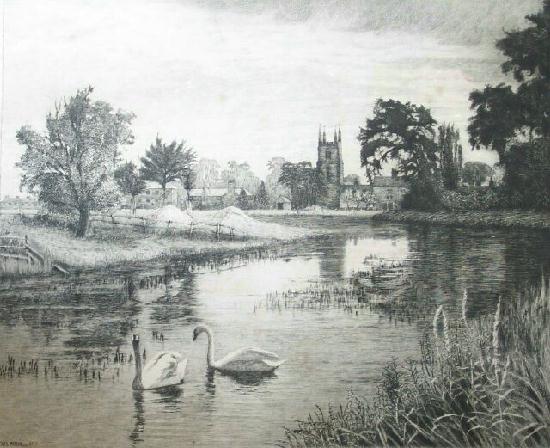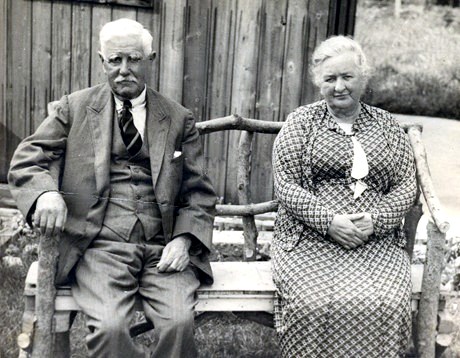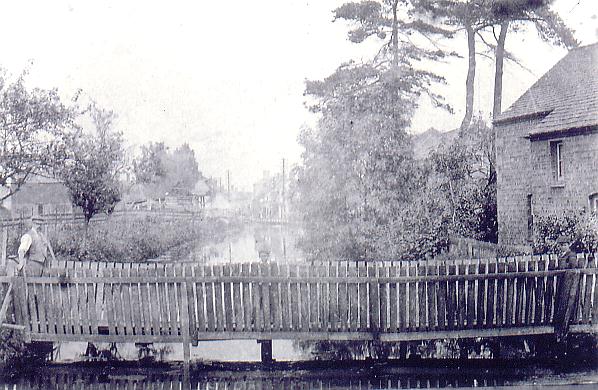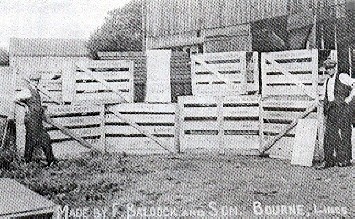|
Mill owners in past times

Baldock's Mill in 1888 from an engraving by Fred Miller
The mill was part of the Marquess of
Exeter's estate and from 1856 it was operated by Robert James Shilcock who also
owned the Star Brewery in Manning Road which produced beer for many public
houses, including the Nag's Head which was run by his brother, John Baxter
Shilcock.
Thomas Pick was employed as his manager from 1876 until 1885 and he was succeeded by William Hudson who continued in the job until 1890. Subsequent millers were William Townson from 1896-1900 and John Pocklington
who continued until Frederick Baldock, who was both a miller and a carpenter, took over
in 1905.
He and his wife Annie
had four sons, Frank, Harold, Richard and John Thomas, who was known as Jack. The names
of two of the sons, Frank and Harold, appear on the wooden framed memorial
plaque in Bourne Abbey that lists a Roll of Honour of those who were killed
during the First World War from 1914 to 1918. They are among ninety names under
the heading: "For God, King & Country - The Heroic Dead. Greater Love Hath no
Man than this".
Their names also appear on the cenotaph in the War Memorial
Gardens but with the initials only. Frank, who was born at Stickford, enlisted at the outbreak of the Great War and was serving as a lance corporal with the 6th Battalion, the Lincolnshire Regiment when he was killed in action at Gallipoli on 9th August 1915 in the vicinity of Scimitar Hill, Suvla. His name is also commemorated on the Helles
Memorial in Gallipoli.
He had only been married for a few years before
his death and the couple had one child. Harold was a Boy 1st Class with the
Royal Navy but died at the age of 17 while serving aboard HMS Natal, a
13,500-ton armoured cruiser when it sank on 30th December 1915 after an
accidental internal explosion at Cromarty Harbour in Scotland, causing the death
of 421 men out of a complement of 704. His name is also commemorated on the
Chatham Naval Memorial. Jack, the third son, was wounded in action but survived
the war and rejoined his father at the mill.
|
Mill owner Frederick Baldock
(1863-1938) and his wife Annie (née
Hipkin 1869-1938)
pictured outside the building that his family occupied for more than
sixty years. The building is still known today by the name Baldock's
Mill. |
 |
|
 |
Jack Baldock, the
last tenant, pictured on the Bourne Eau behind Baldock's
Mill with his son Richard in a motor-powered punt. Richard was
killed in a motor cycle accident on the Spalding Road soon after
this picture was taken in July 1937. |
|
A wooden bridge once
straddled the Bourne Eau behind Baldock's Mill to give easy
access to the field behind, then known as Baldock's Paddock but now
the War Memorial Gardens. |
 |
|
Frederick Baldock
was more occupied with carpentry than milling, having served his
apprenticeship at Keal Cotes, near Spilsby, and even after moving
to Bourne he worked primarily in this trade. His workshop was on
the land attached to the mill that now forms part of the Wellhead
Gardens. |
 |
|
The business was a prosperous one,
specialising in crates for packaging, gates and fences, but the
building was demolished to make way for the Darby and Joan Hall
which was built in 1959. |
The name Baldock (also Baldick) actually means Baghdad and dates back to the 12th century, from the town Baldock in Hertfordshire, England, founded by the Knights Templar who named it after the Arabian city then known to them as Baldac, an early French form of the name. A 12th century record also gives the name as Baldoce. Recorded Baldocks in England include Hugh de Baldoca (1185), Thomas Baldac (1280) and William Baldocke (1460).
Frederick Baldock ran the business until 1930 when his son Jack took over and after his death
in the summer of 1960, aged 66, his daughter Mrs Betty Ray continued the family tradition and was the last person to occupy the mill where she lived with her mother who finally moved out in 1968. The Baldock family were therefore associated with the mill for more than
sixty years and it seems probable that
there is also a distant family connection with the original owners of a Baldock's Mill in the United States because in past centuries, families tended to remain in the same occupation, although that is less true today.
In 1741, a convict called Richard Baldock was sentenced to be deported from England to the colonies for seven years after being found guilty of stealing a cow but he married after his release and his son, also called Richard, built Baldock's Mill in Amherst County, Virginia. This mill continued in business until 1940 when it was sold and although the
building has been destroyed on two occasions, once by flood and then by fire, it
has since been rebuilt and is now known as Brightwell's Mill.
|
MEMORIES OF THE MILL |
|

IN THE PICTURE: The young Betty Baldock (with
parasol) and friend in the boat built by
her father. In the front are her sister Joan with woodwork teacher
Jack Rayner. |
|
THE LAST PERSON to live at Baldock's Mill was
Mrs Elizabeth (Betty) Ray, younger daughter of Jack Baldock who died in 1960, aged 66, and whose family were in
occupation for almost 60 years. On 17th August 1979, Mrs Ray,
then living with her husband, Leslie, in Mill Drove, Bourne, related
her experiences to the Stamford Mercury when she dispelled
some of the myths that had surrounded the building.
"I was four years old when the family moved in where my grandfather
had lived before us", she said. "In my early days, the mill belonged
to the Marquess of Exeter and I remember him coming to the mill with
his agent. One of my earliest recollections is of going by bus to
pay the rent at their office in Stamford.
"It is certainly not true that coffins were made at the mill as has
been rumoured, either by my grandfather or my father. Also, my
father never wore a white coat and never employed a boy. After the
First World War (of 1914-18), the mill ceased grinding corn and my
grandfather retired and part of the premises were sub-let and used
as an egg auction room.
"My father had been wounded in the war and saw his brother (Frank)
killed in the Dardanelles. He had trained as a carpenter and when he
came back, set up in business at the mill making gates and fences
for local farmers. The mill itself was used only as a sawmill and
this continued until the late 1950s when he gave up the work.
"When I was a girl, my brother Dick could often be seen chugging up
and down the river in South Street in a flat-bottomed boat made by
my father. We had many happy times in that boat and Dick later
fitted it with a motor.
"One of my abiding memories is of the herbalist, John Francis, who
had a small hut in the mill garden. He was a bachelor and spent most
of his time collecting herbs from the surrounding fields, drying
them and making medicines.
"In those days, the War Memorial Gardens were part of the mill
paddock and the fire brigade used to practice there. The Bourne
workhouse was also operating in those days and tramps on their way
there for a night's lodging often called at the mill asking for
water and 'a bit of tea'. During the last war (1939-45), when the
German bomber was shot down over Eastgate, one of the crew who had
baled out hid his revolver beside the mill in what we now call
Baldock's Passage." |
REVISED
JUNE 2011
See also Frank
and Harold Baldock
Return to
Baldock's Mill

Go to:
Main Index
|





